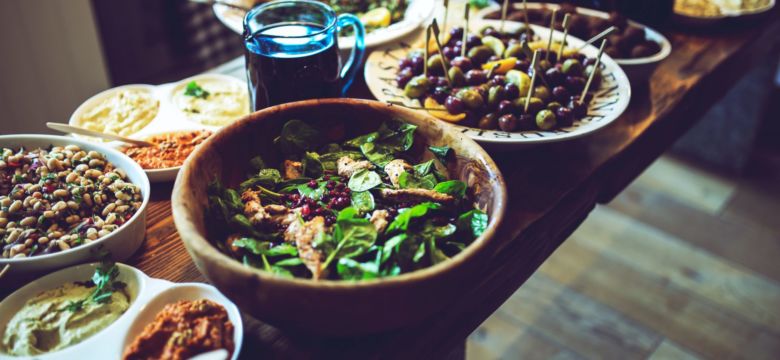
Five Ways to Eat for Fertility Over the Holidays
This week marks the celebration of Thanksgiving. Even though this holiday has a reputation for over-indulgence, holiday dining can still be healthy eating! If this year sees you eating with conception in mind – that is, if you’re actively trying to have a baby, or are considering trying to conceive in 2021 – then preparing with good nutritional choices is especially important. Read on for five ways to ensure your holiday meals are packed with nutrition to support your goals through the new year and beyond.
Go Dark
…Dark meat, that is. The turkey is one of the more healthful options on the holiday table, especially if you have some control over the source – when possible, choose pastured, organic-fed poultry to reduce your exposure to pesticides and hormones that could disrupt your reproductive health. Contrary to popular belief, turkey is more nutritious if you go for the dark meat – thighs, legs, wings and back. Breast meat is lower in fat and calories, but lacks the abundant minerals present in dark meat, which is higher in iron, zinc, and B vitamins, all of which are necessary for reproductive health in both women and men.
Brassica Vegetables
Brussels sprouts, broccoli, cauliflower, cabbage, collard greens, kale… all of these are members of the nutritional powerhouse brassica family, which are fabulous sources of antioxidants Vitamin C, Vitamin E, folate, and fiber. Brassicas are excellent estrogen regulators. Yes, it is possible to have too much estrogen, and eating your broccoli (or brussels, or cauliflower, or grandma’s collard greens) can help to sweep it out of your system. These wonder-veggies can also improve your body’s response to insulin, which helps to optimize blood sugar levels and contributes to maintaining a healthy weight.
Winter Squash and Root Vegetables
Winter squash, sweet potatoes, and carrots are all holiday superstars, with the added bonus of being in-season – autumn is their harvest time (this is important because fresher vegetables that haven’t traveled long distances or been stored for long periods retain more of their nutrients, which means you will consume more micronutrients when you eat seasonally). Provided your root vegetables of choice haven’t been steeped in butter, salt, or even marshmallows, they make an incredibly nutritious side and are a great source of Vitamin C, beta carotene (a precursor to Vitamin A), magnesium, fiber, and Vitamin B6. If your family recipe calls for adding some sweet to the mix, go for something natural and plant based like maple syrup, and go easy – a little goes a long way!
Healthy Fats
There’s still a place for butter and other fats at the Thanksgiving table – just in moderation and from good sources, like a dairy that uses grass-fed and pastured animal products (Kerrygold is a common brand that you can find at most grocers). This is because grass-fed dairy is a good source of Vitamin A, Vitamin K, and omega 3. Other healthy sources of fat for cooking and baking include coconut oil, avocado oil, ghee, and organic nut butters. You’ll want to stay away from margarine and other highly processed butter substitutes – these can be inflammatory and have a poor nutritional profile.
Life is Sweet
Reducing sugar while preparing to conceive is important because sugar is inflammatory and causes oxidative stress to the body, which in turn can impact egg production and implantation. Occasional treats like a slice of pie following Thanksgiving dinner are natural breaks in the context of an overall healthy diet; however, when possible consider modifications like paleo versions of baked goods and desserts, since these are also very tasty but have less of a glycemic load than conventional baked goods. When monitoring your sugar consumption on a holiday, also consider hidden sources of sugar such as sauces (cranberry sauce, for example, contains more sugar than some candy bars) and wine, especially white wine.
By eating with these five factors in mind, you can celebrate while continuing to optimize your reproductive health. Enjoy!
References
Fontana, R., & Torre, S. (2016). The deep correlation between energy metabolism and
reproduction: a view on the effects of nutrition for women fertility. Nutrients, 8(2), 87.
Wilcox G. (2005). Insulin and insulin resistance. The Clinical biochemist. Reviews, 26(2), 19–39.
Yadav, S. P., Vats, V., Ammini, A. C., & Grover, J. K. (2004). Brassica juncea (Rai) significantly prevented the development of insulin resistance in rats fed fructose-enriched diet. Journal of ethnopharmacology, 93(1), 113–116. https://doi.org/10.1016/j.jep.2004.03.034
Yao, D. F., & Mills, J. N. (2016). Male infertility: lifestyle factors and holistic,
complementary, and alternative therapies. Asian journal of andrology, 18(3), 410.
The Role of Calcium, Magnesium, and Zinc in Pre-Eclampsia:
https://link-springer-com.ezproxy.cul.columbia.edu/content/pdf/10.1007%2Fs12011
-009-8423-9.pdf
Pregnancy diet: Focus on these essential nutrients. (2019, December 19). Retrieved November 20, 2020, from https://www.mayoclinic.org/healthy-lifestyle/pregnancy-week-by-week/in-depth/pregnancy-nutrition/art-20045082


